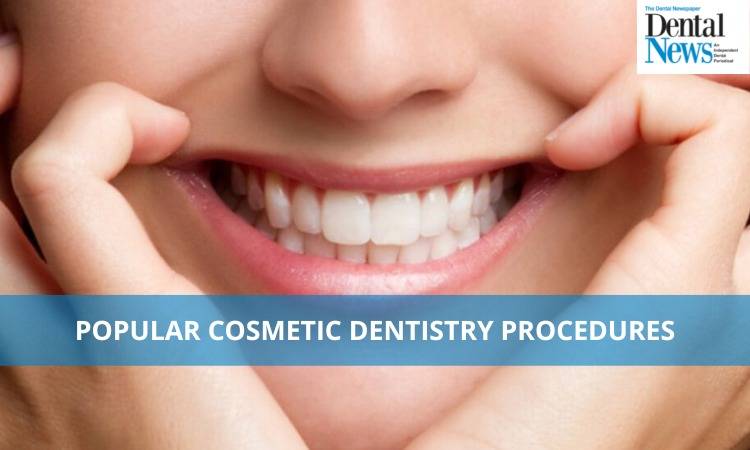
One of the earliest things people observe about you is your smile. This is why so many people continually look for solutions to get the perfect smile. In addition to restoring teeth that are missing, decaying, or damaged, cosmetic dentistry can enhance the overall appearance of your smile.
With more people looking for solutions to enhance or repair the appearance of their smiles, cosmetic dentistry is more common than before. A remarkable 99.7% of Americans, according to the American Academy of Cosmetic Dentistry, believe that a smile is a valuable social asset, and 74% think that having an unpleasant smile could hinder career success. Today's aesthetic dental procedures might occasionally include restorative elements as well.
Here are the top seven procedures used in cosmetic dentistry today:
Dental Bonding
Tooth bonding is an alternative to veneers that offers immediate results by using a laser or ultraviolet light to adhere a composite plastic resin that is tooth-colored to the tooth's surface. The process hides tooth enamel defects, gaps between teeth, and tooth discoloration. When the resin is placed in a cavity, bonding can also be used to fix decayed teeth. While veneers are produced specifically for each patient in a lab, bonding can be completed in just one dental visit. One of the easiest and least expensive cosmetic dental procedures is bonding, however, it requires replacement more frequently than veneers do.
Teeth Whitening
A common cosmetic procedure used to whiten stained or discolored teeth is teeth whitening. It can improve teeth by 5 to 10 shades in just one visit by removing both internal and external stains. Cleaning the teeth to get rid of any plaque or other dirt comes first in teeth-whitening process. The teeth are then coated with a whitening chemical. In some instances, whitening trays or an activation light may be employed. Before being rinsed off, the whitening chemical will stay on the teeth for 30 to 60 minutes. Depending on your oral hygiene and eating habits, the benefits of tooth whitening will last roughly a year. The whitening ingredient will continue to lighten the teeth for the first 24 hours after application.
Dental Crowns
Dental crowns are caps that cover the entire exposed tooth surface. Prior to application, they can be altered in terms of size, shape, and color. They are the best option for repairing teeth with mild dental decay or damage since they cover the whole surface of the tooth. They are also typically used to protect the teeth following root canals. Dental crowns can also replace a single lost tooth when used in conjunction with a dental implant.
Porcelain Veneers
Porcelain veneers may be the solution for those teeth whitening is not an option, whether because of persistent intrinsic tooth discoloration or another functional issue. A porcelain cover is made to fit over a prepared tooth to address the problems with worn enamel, irregular alignment or spacing, chips or cracks, or discoloration. Porcelain veneers are a wonderful option if you don't like how your teeth look and want to create the ideal smile. However, keep in mind that, in contrast to whitening, veneer application is an invasive treatment that necessitates the permanent change of your natural teeth.
Invisible Braces
Consider invisible braces if you want an orthodontic option that does not include a mouth full of wire and bracket braces. Options for invisible braces include inside braces (positioned on the back of teeth), clear aligners, ceramic brackets that match teeth, and more like Invisalign or Clear Correct. It is necessary to assess each category individually because they are not always compatible.
Dental Implants
Modern dental implants provide significant advantages over traditional tooth replacement techniques in terms of aesthetics and function. They feel and look like your natural teeth, and they can be used in place of bridges, dentures, or as the foundation for a dental plate.
A little titanium post called an implant is placed in its bone socket when a tooth is missing. The implant is fixed firmly in place in the jaw as the jaw bone regenerates around it. An abutment is inserted to retain the new tooth firmly once the implant has connected to the bone. The abutment is then covered with a crown. The closest thing to natural teeth is an implant, and once the implant has joined to the bone, artificial teeth supported by implants feel entirely natural.
Gingival Contouring
A gummy smile, in which an excessive quantity of gum tissue is revealed when smiling, is a typical smile concern shared by many people. Treatment options for gummy smiles, also known as excessive gingival display, include surgical lip repositioning, laser therapy, orthodontics, maxillofacial surgery, and gingival sculpting. Periodontists, orthodontists, and occasionally oral surgeons specialize in performing gingival reshaping procedures.
Why would someone want to know more about the numerous cosmetic dental procedures that are currently available? To make them look better when they smile. While it is essential to visit the dentist regularly to take care of any dental work required to ensure that a patient's oral health is as good as it can be, a competent dentist can also provide the cosmetic dental procedures that many people are seeking these days.

Dr Amna Bilal
The author is a contributing writer at Dental News Pakistan and can be reached at amna0795@yahoo.com

